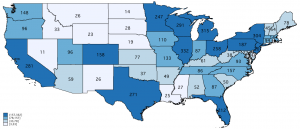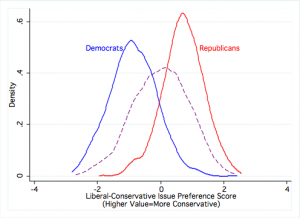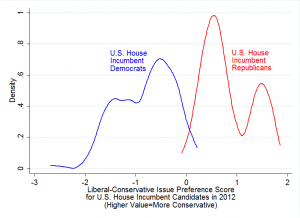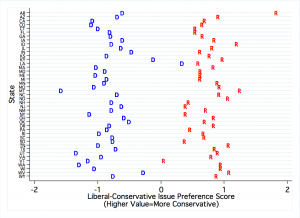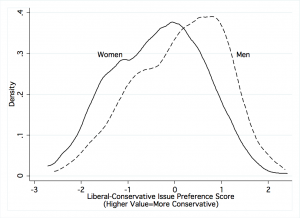The American Municipal Officials Survey was first conducted in the summer of 2012. Each iteration of the survey includes different projects and survey questions. Below are some of the results from that survey, focusing on the issue position questions at the end of the survey. (NOTE: The 2016 and 2014 surveys do not have similar questions about respondents’ issue positions.)
Survey Sampling Frame
The sample of municipal officials for the survey was constructed by first using the census to choose a sample of cities from across the United States. Student research assistants then searched for the website of each town or city in the sample. From the website they collected the name and email address of the elected legislators (e.g., city councilors, alderpersons) and elected executive (e.g., mayor, first selectman). Ultimately, over 4,000 officials from all across the United States participated in the survey. Figure 1 shows the number of survey respondents from each state.
Questions Used to Measure Respondents’ Issue Preferences
At the end of the 2012 survey, respondents were asked their position on 25-30 issues. These questions were randomly chosen from a list of 53 possible questions. The questions were taken from a list of questions that Project Votesmart asks of state and national candidates. Each of the questions mimic roll call votes in that they ask respondents to agree or disagree with each position (and also did not allow for nuance).
We used the responses to these questions to measure each respondents issue preferences. A full description of the technique is beyond the scope of this report, but you can read about how a similar technique is used to measure the preferences of members of Congress.
The aggregate results for each question are provided at the end of this report.
Municipal Officials are Much Less Polarized
Figure 2 provides the distribution of the issues preferences (as measured by respondent’s answers to the questions in the survey) by their self-identified partisanship. The Republicans and Democrats are labeled in the Figure. The independents are the distribution represented by the dashed line. As would be expected, Republicans are more conservative than Democrats and Independents, while Democrats are more liberal. There is however significant overlap between the two parties. More than 50 percent of the Democrats are more conservative than the most liberal Republican and more than 50 percent of Republicans are more liberal than the most conservative Democrat. The significant amount of overlap at the municipal level, combined with a large number of ideologically moderate independents, bodes well for the prospect of cooperation at the municipal level.
Figure 3 shows similar results as Figure 2, except that the issue preferences are from incumbents in the U.S. House of Representatives in 2012. The data for this graph come from Boris Shor (“2012 Congressional Candidate Ideology Scores“) and are created using a similar set of issue position questions from Project Votesmart. One striking difference between Figures 2 and 3 is how little Republican and Democratic House members overlap in their issue preferences relative to municipal officials.
The Partisanship Breakdown by State
Figure 4 shows the partisanship breakdown by state. The differences between the two parties at the municipal level is fairly consistent across states. There are outliers of course. Republicans in Arkansas and Democrats in Louisiana are more conservative than their partisan counterparts in other states. While Republicans in Vermont and Democrats in Montana are more liberal than their fellow partisans elsewhere.
Do Demographics Predict Ideology Beyond Partisanship?
We also looked at four demographics: education, income, race, and gender. Gender was the only one of these demographics for which there was a significant difference, and gender continues to be a significant predictor even when controlling for officials’ partisanship.
Figure 5 shows the differences by gender. Men are more conservative than women. However, there is again a great deal of overlap.
Results by Individual Questions
Table 1 shows the list of questions from Project VoteSmart that were used to measure municipal officials’ ideology (or issue preferences). It also shows what percent of respondents who answered each question said “Yes.” Since our sample may not be representative of all city officials, these results do not necessarily reflect the views of all city officials across the U.S.
As discussed above, the questions are supposed to mimic roll call votes in that they asked respondents to agree or disagree with each position. Keep in mind that this process does not allow for nuance. In addition, in order to make comparisons between the positions of elected municipal officials to those of state legislators and members of Congress, we had to ask questions that deal with issues that municipal officials do not handle in their policy-making decisions.
Table 1: Percent of respondents who support each issue stance
| Issue Position Question | % of Respondents Answering “Yes” | |
| 1 | Do you support eliminating public funding for abortions and public funding of organizations that advocate or perform abortions? | 45% |
| 2 | Do you support federal funding to create lines of stem cells from new embryos? | 65% |
| 3 | Do you support prohibiting the late-term abortion procedure known as partial-birth abortion? | 59% |
| 4 | Should abortions always be legally available? | 63% |
| 5 | Do you support including sexual orientation in your state’s anti-discrimination laws? | 71% |
| 6 | Do you support requiring that crimes based on sexual orientation be prosecuted as federal hate crimes? | 54% |
| 7 | Should your state recognize civil unions between same-sex couples? | 64% |
| 8 | Do you support affirmative action in state college and university admissions? | 43% |
| 9 | Should the federal government consider race and gender in government contracting decisions? | 22% |
| 10 | Do you support opening a select portion of the Arctic National Wildlife Refuge for oil exploration? | 60% |
| 11 | Do you support requiring the federal government to reimburse citizens when environmental regulations limit use of privately owned lands? | 55% |
| 12 | Do you support the U.S. re-entering the Kyoto treaty process to limit global warming? | 52% |
| 13 | Should state environmental regulations be stricter than federal law? | 44% |
| 14 | Do you favor allowing citizens to carry concealed firearms? | 61% |
| 15 | Do you support banning the sale or transfer of all forms of semi-automatic weapons? | 49% |
| 16 | Do you support increasing restrictions on the purchase and possession of firearms? | 50% |
| 17 | Do you support amnesty for certain illegal immigrants who already reside in the U.S.? | 62% |
| 18 | Do you support establishing English as the official and recognized language of the U.S.? | 72% |
| 19 | Do you support prohibiting states from passing laws that deny human services (medical care education) to illegal immigrants or their children? | 43% |
| 20 | Do you support the enforcement of federal immigration laws by state and local police? | 70% |
| 21 | Do you support using military tribunals to try suspected terrorists when ordinary civilian courts are deemed inappropriate or impractical? | 80% |
| 22 | Should law enforcement agencies have greater discretion to monitor domestic communications, to prevent future terrorist attacks? | 46% |
| 23 | Should the U.S. contribute more funding and troops to United Nations peacekeeping missions? | 31% |
| 24 | Should the U.S. support the creation of a Palestinian state? | 52% |
| 25 | Do you support decriminalizing the possession of small amounts of marijuana? | 62% |
| 26 | Do you support imposing truth in sentencing for violent criminals so they serve full sentences with no chance of parole? | 74% |
| 27 | Do you support limiting the number of appeals allowed to inmates on death row? | 68% |
| 28 | Do you support the death penalty in your state? | 61% |
| 29 | Do you support increasing the minimum wage? | 56% |
| 30 | Do you support providing direct financial assistance to homeowners facing foreclosure? | 36% |
| 31 | Do you support reducing government regulations on the private sector in order to encourage investment and economic expansion? | 69% |
| 32 | Do you support the right of workers to unionize? | 80% |
| 33 | Do you support a merit pay system for teachers? | 83% |
| 34 | Do you support abstinence-only sexual education programs? | 24% |
| 35 | Do you support increasing state funds for hiring additional teachers? | 65% |
| 36 | Do you support providing parents with vouchers to send their children to any participating school: public private or religious? | 50% |
| 37 | Is the tenure process for public school teachers producing effective teachers? | 15% |
| 38 | Do you support allowing doctors to prescribe marijuana to their patients for medicinal purposes? | 71% |
| 39 | Do you support implementing a universal health care program to guarantee coverage to all Americans regardless of income? | 54% |
| 40 | Do you support monetary limits on damages that can be collected in malpractice lawsuits? | 77% |
| 41 | Do you support requiring individuals to purchase health care insurance? | 43% |
| 42 | Do you support implementing a government-financed single-payer national health care system similar to that of Canada? | 41% |
| 43 | Do you support making President Bush’s tax cuts permanent? | 52% |
| 44 | Do you support replacing the U.S. income tax structure with a flat income tax? | 61% |
| 45 | Do you support the permanent repeal of the federal estate tax? | 58% |
| 46 | Do you support increasing federal taxes on gasoline and diesel fuels to promote conservation and alternative fuel development? | 40% |
| 47 | Do you support increasing employment and job training programs for welfare recipients? | 90% |
| 48 | Do you support limiting the benefits given to single women if they have additional children while receiving welfare benefits? | 69% |
| 49 | Do you support programs that provide job training and placement services for at-risk youth? | 95% |
| 50 | Do you support providing child care for welfare recipients who work? | 81% |
| 51 | Do you support redirecting welfare funding to faith-based and community-based private organizations? | 39% |
| 52 | Do you support cutting taxes, even if it means deep cuts in government programs? | 51% |
| 53 | Do you support efforts to consolidate 911 services with neighboring areas as a way to save municipal funds? | 86% |

